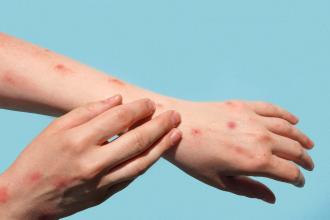Syphilis and neurosyphilis increase to historic levels in BC
Syphilis is an age-old sexually transmitted infection (STI) that typically passes through three clinical stages and may be latent (without overt signs or symptoms). Primary syphilis is highly contagious, occurs between 3 days and 3 months after sexual exposure, and classically presents as a painless, indurated ulcer (but can be quite variable). This most infectious lesion is commonly seen in the genital area, but can be easily missed if it occurs in the rectum, vagina, or mouth.
Secondary syphilis, which occurs between 3 weeks and 6 months, is contagious by intimate sexual contact, and consists of a generalized body rash that may involve the palms, soles, and mucosal surfaces. Tertiary syphilis occurs years to decades after infection, and consists of a variety of lesions (gummas) that can occur at sites anywhere on the body including the brain, spinal cord, or vasculature. Neurosyphilis can occur early or late. Latent syphilis, diagnosed by serologic tests alone, is considered infectious if determined to be contracted within 1 year by comparing to a previous test or recent risk factors.
Syphilis rates have been increasing in several global jurisdictions over the past two decades. In BC, the recent numbers are alarming. In 2012 the rate was the highest it has been in over 30 years (Figure). In the 1990s, syphilis was mostly associated with the heterosexual sex trade, most highly affecting Vancouver’s Downtown Eastside. Since the early 2000s, syphilis has shifted to predominantly affect gay, bisexual, and other men who have sex with men (MSM). There is a significant overlap with the HIV epidemic; approximately 60% of syphilis diagnoses occur in individuals with HIV infection.
Most serious complications of syphilis relate to vertical transmission in expecting mothers (fetal loss or congenital syphilis) or nervous system involvement in adolescents and adults. The most recent congenital syphilis diagnosed in BC was in 2009. Neurosyphilis, however—which can lead to headaches, psychiatric symptoms, hearing or vision loss, or even strokes in young people—is on the increase. In 1992 the neurosyphilis rate was 0.03 per 100000 population in BC; in 2012 the rate was 0.8 per 100000 (27-fold increase). The best way to avoid complications of syphilis is preventing infection, as well as early diagnosis and treatment.
Testing, treatment, and prevention recommendations
Syphilis prevention should be included in sexual health counseling. Barrier methods such as condoms reduce syphilis transmission. Syphilis can be diagnosed through a blood test—rapid plasma reagin (RPR) for general screening, and add “confirmatories” (treponema pallidum particle agglutination and fluorescent antibody-absorption tests) when testing sexual contacts.
Direct lesion tests are used for suspected chancres (direct fluorescent antibody test). Other tests such as polymerase chain reaction are available on special request. A syphilis test should generally be included with every STI screen or HIV test (with the exception of universal HIV testing in low-risk settings).
In individuals at high risk of acquiring syphilis, such as MSM with new sexual partners (including oral sex), syphilis screening should be offered every 3 to 6 months. In individuals with known HIV infection, syphilis testing (RPR) should be added to routine quarterly blood work. If neurologic deficits are identified in individuals diagnosed with syphilis, they should be referred to an infectious disease specialist or neurologist to rule out neurosyphilis. Testing and treating cases and sexual contacts is central to syphilis control.
Treatment of syphilis varies from one to three sets of long-acting intramuscular benzathine penicillin G (Bicillin) depending on the suspected duration of infection (early, late, or unknown duration). Intravenous penicillin is used for neurosyphilis. Bicillin can be ordered and shipped for free from the BCCDC.
All diagnosis and treatment of syphilis in BC is coordinated centrally through the BCCDC, through which Bicillin can be ordered. The direct line for the syphilis public health nurse is 604 707-5607, and the physician contact number is 604 707-5606.
— Richard T. Lester, MD, FRCPC
BC Centre for Disease Control, University of British Columbia
—Muhammad Morshed, PhD, SCCM
BC Public Health Microbiology and Reference Laboratory, University of British Columbia
—Mark Gilbert, MD, FRCPC
—Travis Hottes, MSc
BC Centre for Disease Control
This article is the opinion of the BC Centre for Disease Control and has not been peer reviewed by the BCMJ Editorial Board.
Suggested reading
1. Public Health Agency of Canada. Canadian Guidelines on Sexually Transmitted Infections: updated January 2010. Accessed 28 March 2013. www.phac-aspc.gc.ca/std-mts/sti-its/cgsti-ldcits/section-5-10-eng.php.
2. SmartSex Resource. BC Centre for Disease Control. Accessed 28 March 2013. http://smartsexresource.com/.
3. BC Centre for Disease Control. Sexually Transmitted Infections. Accessed 28 March 2013. www.bccdc.ca/dis-cond/comm-manual/CDManualChap5.htm.

